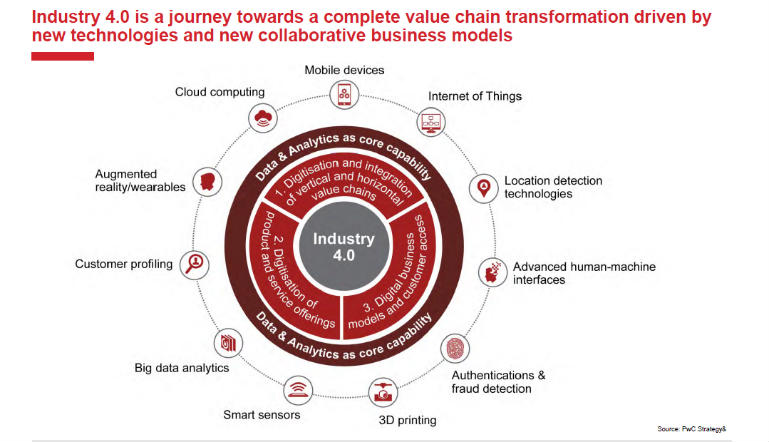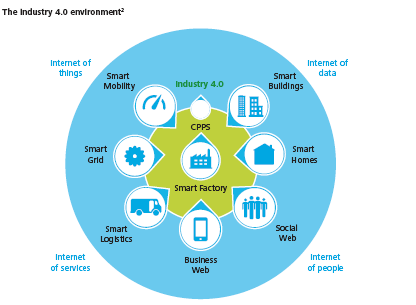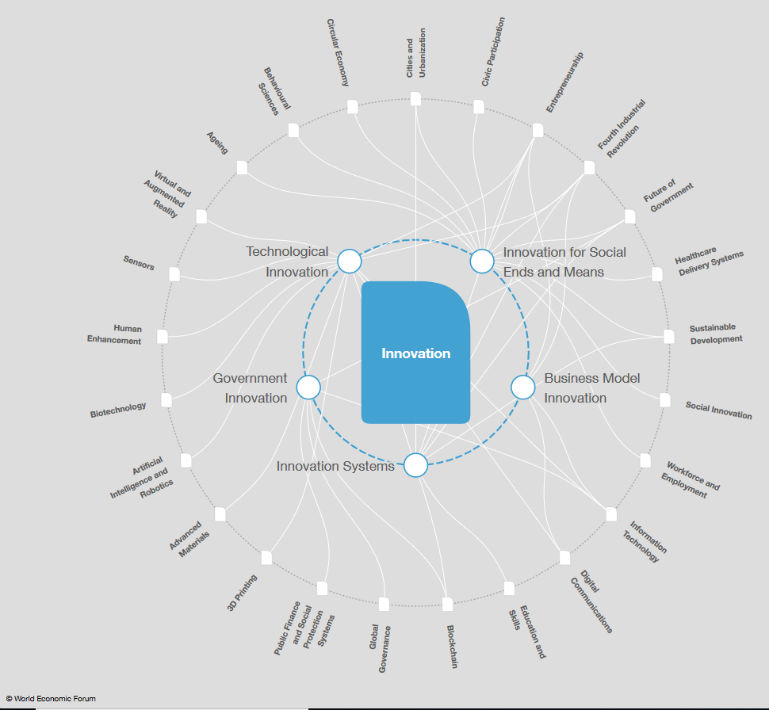There are twin forces at work, feeding off each other. We are facing greater disruption and an increasing innovation pace. These are constantly combining, relentlessly adding new shape to our future. We are actually caught up in a very revolutionary period.
The days of simple product innovation are dwindling. It is through the fourth industrial revolution (also known as Industry 4.0), currently being undertaken, that technology, talent, and new innovation ecosystems are emerging – building greater complexity into our final innovation offerings. Intelligent automation and technology are fuelling this new industrial revolution. And this unprecedented, exponential pace of change is increasingly reliant on collaborative platforms to realize the result: more radical innovations.
Innovators struggle to manage in a new way
Organizations everywhere are facing mounting pressure to transform – to shift from product-centric business models to new models focused on creating and capturing different sources of new value. As a result, innovation is becoming more complex.
At the heart of this transformation is the fourth industrial revolution. Here, manufacturing is fast becoming the digital manufacturing enterprise (DME). The DME is designed to increase response rate and manage in more efficient, connected, and effective ways. There is this growing recognition that everything needs to be connected to bring a different perspective to any global value chain –one of being far more responsive and bringing manufacturing closer to the customer need.
How does your organization feel about our digitally connected world? We are all becoming more connected in the way we work, collaborate, and manage. Organizations are attempting to “fuse” different technologies to manage the existing physical world differently and are preparing themselves for the interplay between the physical and virtual world – one where this “connecting up” is promising to bring us. The ongoing investment in IT infrastructure is drawing in investments. It is changing the nature of where we will look for innovation outcomes in the future.
The fourth industrial revolution is one where we are gaining new knowledge and understanding. It is offering a very different potential for constructing new business models, products, services, and societal solutions. Many manufacturers are still in the early stages of this fourth revolution, but you have this sense of feeling that we are continuing to disrupt everything we know.
Welcome to the 4th industrial revolution
Wherever we turn in the manufacturing world, the technological revolution immerses us. The scale, scope, and complexity are things we’ve certainly never experienced. It is exposing us to exponential technologies. But what does that mean?
We seem caught up in such levels of velocity, scope, and systems impact – it is seemingly exponential, occurring at faster rates of change. Companies are radically overhauling entire systems of production, management, and governance on a constant basis of change. We have unprecedented processing power, storage capacity, and access to various avenues of knowledge. These are being combined with emerging technology in fields such as artificial intelligence, robotics, 3D printing, nanotechnology, biotechnology, material science, and quantum computing. It is creating fresh challenges and opportunities within innovation. Are we equipping ourselves to explore these?

Of course, we have faced industrial revolutions before. But, being caught up in one tends to leave us often conflicted. The first industrial revolution was based on water and steam to mechanize production. The second revolution was the use of electric power that led to the creation of mass production. Then we had the third revolution, where electronics and information technology started to deliver automated production. This fourth one builds on the third. It is the digital revolution where we are witnessing a fusion of technologies that seem to be blurring the lines between those past established borders to open up different meaning and business potential. It is truly exponential.
Confronted in multiple ways
We are looking increasingly to our engineers, designers, and scientists to unlock these new knowledge flows that bring us whole new areas of technological-based innovation. Product innovation is continually giving way to new concepts that have technology built into them. Our innovation has become increasingly complex, connected, and contextual.
Our industry value chains are being radically redesigned to accommodate “connected worlds” being more reliant on “everything” being digital. This is giving us new options for adapting quality to differently defined market needs. We are learning to respond digitally, in more dramatic and dynamic ways, to reflect pricing opportunity on increasingly opportunity marketing, so as we can appeal to wider sets of audiences or push our offerings out to explore different market potential.
As we continue to design manufacturing to be fully connected-up, we can adjust faster, scale differently, and deliver quantities to varying cycles of demand, closer to the need of the day and more appealing to the customers. Our innovation scope changes with these new dynamics.
Today, we see a different spectrum of choice. We can order personalized clothes online that reflect the latest fashion, seen only days before. Manufacturing and delivery are taking days and not months to be available in-store or delivered to your door. We can design our own shoes. We can build complete vacation packages, designing our travel to meet our specific needs and budget. More and more, we want tailored experiences or solutions that fit our design need, not just “items” sitting on the shelf.
Mass production has given way to tailored design. We can track our orders, and we can engage directly with those that can deliver to our specific needs. Our engagement and growing relationship with customer service, our needs, and the organization’s service and response are all changing. All provide innovation opportunity to exploit.
Manufacturing is in a massive transformation
Manufacturing has progressively formed around cyber-physical product systems (CPPS) that are merging our real and virtual worlds into a seamless one. Software is optimizing every process and task, whether performed by humans or machines. These are ongoing online networks of machines connected in similar ways to our social networks that are linked through technology and digital infrastructures. Everything has become “smart.”

The revolution underway is connecting all the parts: the “internet of things” (IoT), of data, of services, and of people. We are very much still in the middle of this revolution, but it is where innovation will greatly benefit as this connecting-up continues.
We are constantly seeing progress occurring all around us. For example, we’re now more dependent on cloud processing and data storage than ever before. We are recognizing the value of having digital twins to simulate our manufacturing environment. We are designing software solutions specifically to simulate different scenarios, mirroring our real time to test options and optimize different set-ups, to reflect demand.
Our manufacturing plants are becoming far more integrated – virtually integrated. We are building industry 4.0 open standards so increasingly we can connect across manufacturing ecosystems even more, so as to reduce disruption or provide greater flexibility. We are exploring data analytics for learning and predicting, and this is placing a greater emphasis on collaboration, experimentation, exploration, and coordination from all this connecting-up.
Consequences of the 4th industrial revolution
We must reflect on all these direct consequences of the fourth industrial revolution. Where technology has combined with the physical to raise our customer expectations even further, it has given us different product enhancements that fit with our lives, one where we can contribute and collaborate more.
The customer is increasingly at the epicenter of the economy. The products and services are enhanced through the digital capabilities that boost their value and worth. New materials are making our assets more durable and resilient, and data and analytics provide valuable feedback needed to build even better services and performance for the future. All this connecting and reacting is requiring new forms of collaboration, and we are seeing new types of organizations emerging. They are far more dependent on platforms and ecosystems. Innovation is the unlocking mechanism.
We are required to alter our understanding of Innovation due to this 4th revolution
The consequences of the fourth industrial revolution can be seen in the shifts of our emphasis taking place around innovation. We are focusing more of our innovation spend on technological innovation. We are constantly looking at the changes to our existing business models to reflect these changes, and we are integrating our innovation systems to explore entirely new business models.

We are connecting innovation more than ever. For example, choosing a blockchain technology requires significant collaboration and technology understanding. We are reliant on so much to generate “our” innovation solutions, far more than in the past.
The interactive World Economic Forum map is worth exploring. As you click on the links, you quickly recognize how interconnected our innovation has become. Not just in being able to produce accepted solutions but being having a ‘richer’ choice on where to focus our innovation efforts. Our innovation is becoming reliant on the fourth revolution and how it is all connecting us up, to provide our future growth through greater collaboration.
Reference: https://blog.hypeinnovation.com/innovation-fourth-industrial-revolution

